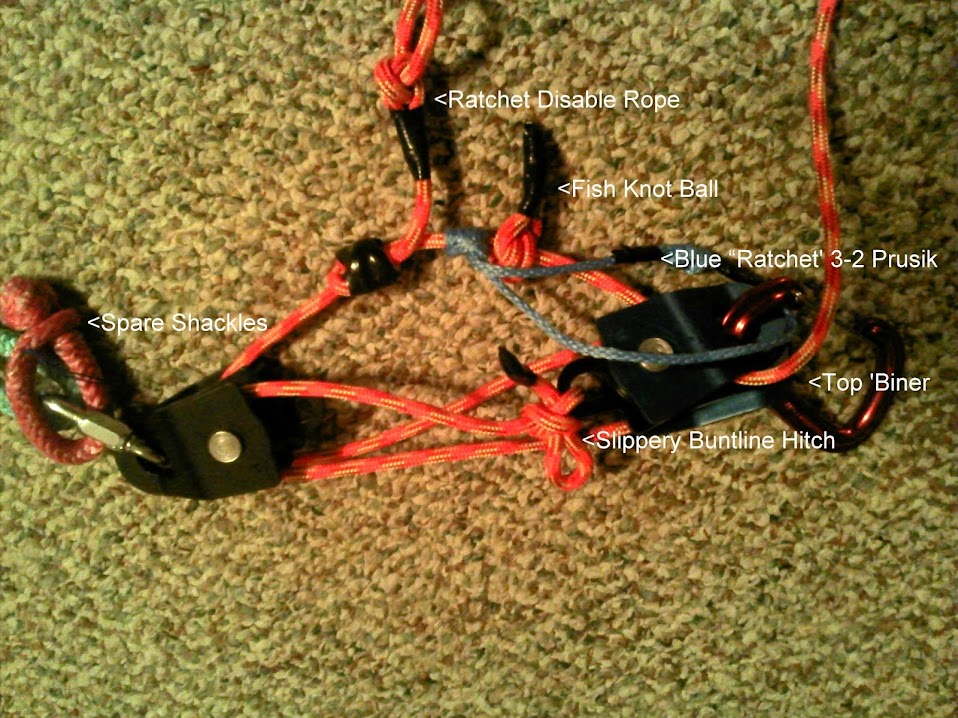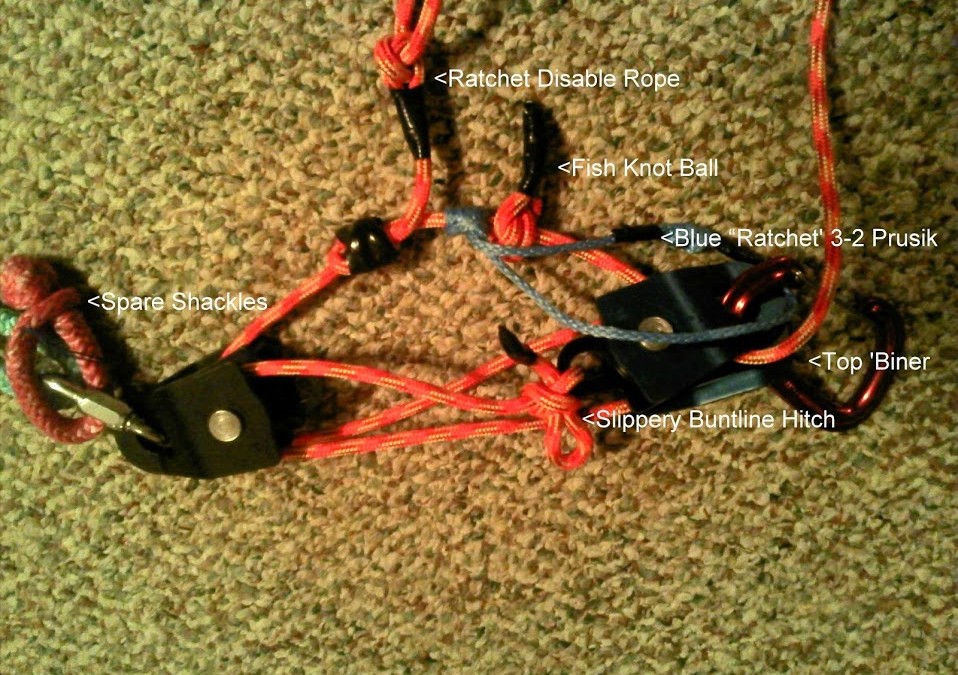Getting your bike back up on the trail after tossing it down a steep side hill can be a major problem, even ride ending if you are solo. We have developed a small self rescue pulley system that has proven to work in getting your bike pulled back on to the trail, even when you are by yourself. The “ratchet” system allows a soloist to hoist the bike up part way, then let go of the pulley rope while you go down and dislodge or adjust the bike without the bike sliding back down the hill.
This is a 4:1 self rescue pulley solution that was tuned to be a smaller package and secure enough for hoisting a motorcycle, without the margin of safety to hoist people. Actually, it is 5;1 when pulling uphill, and 4:1 when pulling downhill I believe. You see, this is my first such attempt at any type of mountaineering gear, so if you are trained, then you may see lots of technical safety errors so I am open to review, questions and advice, but it sure works slick so far with bike weight loads.

It uses two SMC-JRB mini double pulleys ($30 each) with Beckets, 50′ of 5mm utility main rope($15), a short 7/64 blue amsteel for “ratchet prusik” and a couple 5mm ratchet control ropes. The anchor rope to tie off the pulley to a tree or rock is a 50′ piece of 7/64 amsteel ($15). The basic assembly for a similar design can seen here, https://www.youtube.com/watch?v=8po79w2dMRg so you can get a sense of the project and see how to properly thread the main rope thru the pulleys. If the 5mm rope hurts your hands when you pull hard, just grab a stick and wrap the main rope around it a few times, then pull on the stick like a ski rope.
The pulleys and carabiners are rated for 5K+ lbs. The pulley main rope I bought is rated for 1300lbs and the amsteel is 1600lbs rated. But it is really limited by my human pull power so I think the main rope will only see 200lbs with me on the end, and the anchor ropes and bike will see 800lbs with the 4:1 leverage. The 50′ of blue amsteel to be used as anchor ropes can be doubled as needed to reduce the load on your tree/rock tie downs. But always connect them to the pulley rig thru the top carabiner or the bottom quick link to prevent ever tying the main anchor rope to a sharp edge of the pulley tops. You could be done with a useful pulley at this point already by just threading the main rope thru the pulleys. But I already knew from experience that I needed a ratchet feature as a soloist.
The pulley and main 5mm line rope are off-the-shelf fair sized for my needs, but the ratchet rope was trickier so I will explain some details (sorry for long post). To make a ratchet system that supported the smaller ropes that I wanted to use, I had to test a few configurations. The blue ratchet rope is just a a loop formed with double fisherman knots, then slipped over the main rope and attached with a 3-2 prusik knot (see video link for how to tie 3-2 version of prusik) with the 2 twist side towards the pulley. Then the other end of the loop is clipped into the top pulley carabiner (top = right side on the picture). The initial problem with that 5mm main rope combination was that the smallish 7/64 amsteel ratchet rope would suck into the pulley roller when I pulled the main line, so I added the sliding fisherman’s knot ball (labelled Fish Knot Ball in picture) just above the 3-2 prusik it to keep it out of the rollers. I think a properly sized steel washer slid over the main rope, instead of the Fishermans knot ball, might be a cleaner looking way to solve this same issue. When the main rope is pulled by the user, the main rope just slides thru the fisherman knot ball and the 3-2 prusik on the ratchet rope with very little friction. But when the main rope is allowed to extend by the force of the load on the pulleys, the 3-2 prusik grabs the main rope and keeps it from extending. This grabbing can be disabled for pulley deployment with your hand by pushing the 3-2 prusik up while you deploy. But I added the “Ratchet Disable Rope” by tying a sliding fishermans knot on a short piece of rope below the 3-2 prusik (to the left in the picture) and then made a bowline hitch loop at the other end. I made the Ratchet Disable Rope length such that was shorter than the ratchet rope. This is so that when the bowline end of the Ratchet Disable Rope is hooked into the main carabiner with the ratchet rope, then the 3-2 ratchet prusik is unable to extend and thus will not grab/ratchet. But when you want the ratchet to work, remove the bowline end of the Ratchet Disable Rope from the carabiner and the ratchet rope works like normal. If this disable feature is too confusing, remember that this part of the design was just a nice-to-have, since you can disable the ratchet rope with one hand while you extend the main pulley rope with the other hand.
The max extension length of the pulley rig is 12′ with 48′ of main rope and a short 2′ end to pull on when it is in 4:1 mode. But I can untie the slippery bunt line hitch tied to the pulley becket, then move it to the other pulley becket to reduce this to a 3:1 system and have 16′ of pulley length. Of course, my anchor ropes will make the total reach much longer, but 12′ or 16′ is my pull distance before I have to extend the pulley ropes, shorten my anchor rope and pull again.
I hoped these extensive details might help anyone that wanted to make a model of this themselves. Compared to the similar design here: https://www.youtube.com/watch?v=8po79w2dMRg , this off the shelf Aztek solution is bulkier and costs $300. My whole package weights in at 24oz and fits in a 6″x9″ stuff sack. The cost is roughly $100, but I also have spent about that much again in spare parts as I tried different configurations. I have already proven that I need to carry this by using it twice while riding solo.


Recent Comments